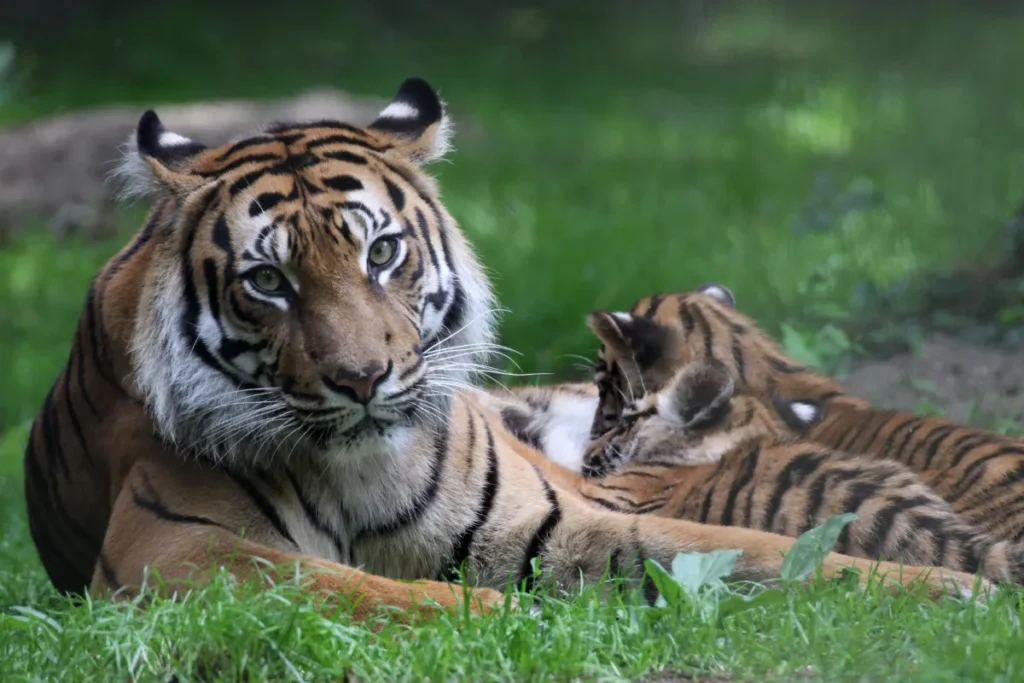Tigers, the epitome of strength, grace, and beauty, are among the most revered creatures on our planet.
With their striking stripes and powerful presence, they captivate the hearts of millions worldwide.
But did you know that not all tigers are the same? Indeed, the world is home to various types of tigers, each with its unique characteristics and habitats.
In this article, we embark on a journey to uncover the diverse tapestry of tiger species, shedding light on their individual traits, habitats, and conservation status.
Bengal Tigers – The Royalty of the Jungle
Bengal tigers, native to the Indian subcontinent, reign supreme as the most numerous tiger subspecies.
With their fiery orange coats adorned with dark stripes, they epitomize the quintessential tiger image.
Roaming the lush jungles and mangrove forests of India, Bangladesh, Nepal, and Bhutan, Bengal tigers are apex predators, commanding respect and admiration.
Siberian Tigers – Giants of the North
Venturing into the cold expanse of the Russian Far East, we encounter the majestic Siberian tiger, also known as the Amur tiger.
Distinguished by their thick fur coats, these giants are adapted to thrive in the harsh climates of the taiga forests.
Siberian tigers are the largest of all tiger subspecies, exuding strength and resilience in their snowy domain.
Sumatran Tigers – Guardians of the Rainforests

In the lush rainforests of Sumatra, a different kind of tiger prowls – the Sumatran tiger.
Smaller in size compared to their cousins, Sumatran tigers possess darker coats and more prominent facial hair.
Endemic to the Indonesian island of Sumatra, these elusive cats face threats from habitat loss and poaching, making them one of the most critically endangered tiger subspecies.
Indochinese Tigers – Survivors in a Changing Landscape
Traveling to the forests of Southeast Asia, we encounter the Indochinese tiger, a resilient survivor amidst rapid environmental changes.
Found in countries like Thailand, Myanmar, Vietnam, Laos, and Cambodia, these tigers boast unique coat patterns, adapted to the dense vegetation of their habitats.
However, like their counterparts, Indochinese tigers face grave threats from habitat loss and illegal hunting.
Malayan Tigers – Guardians of the Peninsula
Exploring the lush landscapes of the Malay Peninsula, we encounter the Malayan tiger, a subspecies uniquely adapted to the tropical rainforests and mangrove swamps of Malaysia.
With their distinctive coat patterns and smaller sizes, Malayan tigers play a crucial role in maintaining the ecological balance of their habitats.
Yet, they too face imminent threats from deforestation and human encroachment.
South China Tigers – Ghosts of the Mountains

Once roaming the forests of southern China, the South China tiger now stands on the brink of extinction, teetering on the edge of existence.
With only a handful left in captivity, these elusive cats serve as a poignant reminder of the perils faced by endangered species worldwide.
Efforts are underway to reintroduce South China tigers into the wild, but their future remains uncertain.
Conclusion:
In conclusion, the world of tigers is as diverse as it is captivating.
From the fiery Bengal tigers of India to the elusive South China tigers, each subspecies adds a unique hue to the tapestry of nature.
However, amidst their splendor lies a stark reality – tigers are facing unprecedented threats from habitat loss, poaching, and human-wildlife conflict.
It is incumbent upon us to take action, to conserve and protect these magnificent creatures for generations to come.
FAQs (Frequently Asked Questions)
Are all tiger species endangered?
While not all tiger subspecies are classified as endangered, the majority of them are facing significant threats to their survival due to habitat loss, poaching, and human-wildlife conflict.
What is the biggest threat to tiger populations?
Habitat loss and fragmentation pose the most significant threat to tiger populations worldwide. Deforestation, urbanization, and agricultural expansion encroach upon tiger habitats, leading to dwindling populations and fragmented landscapes.
How can I contribute to tiger conservation efforts?
There are several ways to support tiger conservation, including donating to reputable conservation organizations, raising awareness about tiger conservation issues, and advocating for policies that protect tiger habitats and combat illegal wildlife trade.
Can tigers be reintroduced into the wild successfully?
While tiger reintroduction efforts have seen some success in certain areas, the process is complex and requires careful planning, habitat restoration, and addressing the root causes of tiger decline, such as poaching and habitat loss.
What role do tigers play in their ecosystems?
Tigers play a crucial role as apex predators, regulating prey populations and maintaining the ecological balance of their habitats. By conserving tigers, we also protect the biodiversity of entire ecosystems.

